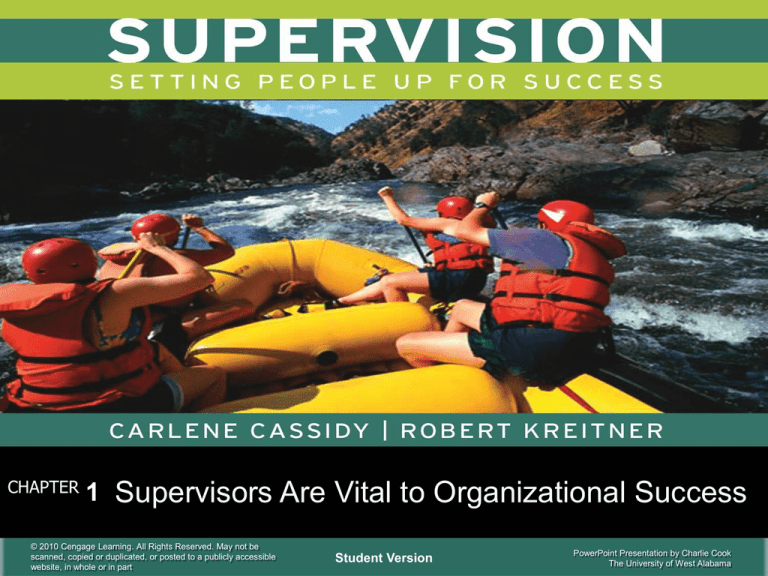
CHAPTER
1 Supervisors Are Vital to Organizational Success
© 2010 Cengage Learning. All Rights Reserved. May not be
scanned, copied or duplicated, or posted to a publicly accessible
website, in whole or in part
Student Version
PowerPoint Presentation by Charlie Cook
The University of West Alabama
Learning Objectives
1. Describe a typical organizational pyramid and identify where
supervisors are positioned in most organizations.
2. List the five functions of management and discuss the functions
supervisors are most likely to be responsible for.
3. Identify and briefly explain various aspects of the supervisor’s role.
4. List essential skills and knowledge needed for a supervisor to be
successful.
5. Identify trends impacting businesses and briefly explain the effect on
supervisors.
6. Discuss organizational basics, including four characteristics common
to all organizations and organizational charts.
7. Describe how a small company or entrepreneurial venture’s
organizational structure and supervisory responsibilities may be
different from those of a larger organization.
© 2010 Cengage Learning. All Rights Reserved. May not be scanned, copied
or duplicated, or posted to a publicly accessible website, in whole or in part.
1–2
Supervisors and
the Organizational Pyramid
• Management
The process of working with and through others to
achieve organizational objectives in a changing
environment.
Supervisors are essential to any organization that
depends on people to achieve success.
© 2010 Cengage Learning. All Rights Reserved. May not be scanned, copied
or duplicated, or posted to a publicly accessible website, in whole or in part.
1–3
Supervisors and
the Organizational Pyramid (cont’d)
• Legal Definition of a Supervisor:
Any individual having authority, in the interest of the
employer, to hire, transfer, suspend, lay off, recall,
promote, discharge, assign, reward, or discipline
other employees, or responsibly to direct them, or to
adjust their grievances, or effectively to recommend
such action, if in connection with the foregoing the
exercise of such authority is not of a merely routine or
clerical nature, but requires the use of independent
judgment.
© 2010 Cengage Learning. All Rights Reserved. May not be scanned, copied
or duplicated, or posted to a publicly accessible website, in whole or in part.
1–4
Managers and Supervisors
Top Management
Responsibilities
Chief executive officer (CEO)
• Strategic planning (one- to ten-year plans)
President
• Major financial and operational decisions
Chief operating officer (COO)
Chief financial officer (CFO)
• Organization-wide personnel and human resource
decisions
Senior vice president; vice president
• Major public relations and marketing messages
General manager
• Overseeing major emergencies and crisis management
events
Division head
Middle Management
Responsibilities
Functional manager
• Intermediate planning (six months to two years)
Product-line manager
• Logistical and operational decisions
Department head
• Budget decisions
Store manager
• Facilities planning
• Staffing and human resource decisions
• Handling isolated crisis management events
© 2010 Cengage Learning. All Rights Reserved. May not be scanned, copied
or duplicated, or posted to a publicly accessible website, in whole or in part.
1–5
Managers and Supervisors (cont’d)
Lower Management
Responsibilities
Unit manager
• Operational planning (one week to one year)
Branch manager
• Meeting production goals/quotas
Department supervisor
• Customer service
First-line supervisor
• Coordinating staffing and work schedules
Shift manager or supervisor
• Personnel and job-assignment decisions
Team leader
• Organizing training, orientation, and team-building activities
Project manager
• Unit-level facilities/resource planning and purchasing
• Day-to-day and local crisis management
• Enforcing job safety regulations and accident reporting
© 2010 Cengage Learning. All Rights Reserved. May not be scanned, copied
or duplicated, or posted to a publicly accessible website, in whole or in part.
1–6
Managers and Nonmanagers
• Exempt Employees
Employees who are exempted from wage and hour
laws in that they are not paid overtime.
• Nonexempt Employees
Employees who are covered by wage and hour laws
that require the payment of overtime.
• U.S. Department of Labor
See how wage and hour laws are applied and
enforced at:
http://www.dol.gov/
© 2010 Cengage Learning. All Rights Reserved. May not be scanned, copied
or duplicated, or posted to a publicly accessible website, in whole or in part.
1–7
1. Why do you think supervisors are important to
organizations and their management structure?
2. Imagine that you work for a large retail store such
as Best Buy or Home Depot and the company
decides to eliminate all lower-level management
positions. What do you think would be the impact
on the employees and the customers?
© 2010 Cengage Learning. All Rights Reserved. May not be scanned, copied
or duplicated, or posted to a publicly accessible website, in whole or in part.
1–8
Managerial Functions and
Supervisory Roles
• Managerial Functions
General administrative duties that need to be carried
out in virtually all productive organizations.
• Fayol’s Universal Management Functions
1. Planning
2. Organizing
3. Commanding
4. Coordinating
5. Controlling
© 2010 Cengage Learning. All Rights Reserved. May not be scanned, copied
or duplicated, or posted to a publicly accessible website, in whole or in part.
1–9
Supervisors Play Many Roles
Trainer
Coach
Planner
Controller
Supervisory
Roles and
Responsibilities
Scheduler
Leader
Motivator
Recruiter
© 2010 Cengage Learning. All Rights Reserved. May not be scanned, copied
or duplicated, or posted to a publicly accessible website, in whole or in part.
1–10
Essential Skills for Successful Supervisors
Communication Skills
Political Skills
Entrepreneurial Thinking
and Creativity Skills
Delegation Skills
Decision-Making Skills
Essential
Supervisory
Skills
Computer/Technology
Skills
Technical Skills
Emotional Intelligence and
Self-awareness
Team-Building and
Leadership Skills
Administrative Skills
Time Management Skills
© 2010 Cengage Learning. All Rights Reserved. May not be scanned, copied
or duplicated, or posted to a publicly accessible website, in whole or in part.
1–11
Trends Impacting Organizations
and Supervisors
Technology
Globalization
Telecommuting, virtual
offices, employee privacy
Outsourcing
Off-shoring
Organizations and
Supervisors
Diverse Workforce
Age, gender, ethnicity,
Work experience
© 2010 Cengage Learning. All Rights Reserved. May not be scanned, copied
or duplicated, or posted to a publicly accessible website, in whole or in part.
1–12
Age diversity creates opportunities and challenges for supervisors. To
explore this concept further, answer the following questions after
visiting Duke University’s Personal Assistance Service (PAS) website
at http://www.hr.duke.edu/pas/.
■ Select the Supervisor Resources link on the left-hand column
■ Select The Multigenerational Workplace link on the lower right
■ Review all five parts:
1. What are some of the characteristics described in Part 2.
Description of the four distinct work groups that apply to your
generation?
2. How should work expectations differ for each generation (see
Part 3. Work performance expectations for these different
groups)? What suggestions does the PAS website have for
supervisors regarding work performance expectations?
© 2010 Cengage Learning. All Rights Reserved. May not be scanned, copied
or duplicated, or posted to a publicly accessible website, in whole or in part.
1–13
The Supervisor’s Organizational World
Common
Characteristics of
an Organization
Coordination
of Effort
Common
Goal or
Purpose
© 2010 Cengage Learning. All Rights Reserved. May not be scanned, copied
or duplicated, or posted to a publicly accessible website, in whole or in part.
Division
of Labor
Hierarchy
of Labor
1–14
Organizational Charts
• Organizational Chart
A visual display of an
organization’s official positions
and formal lines of authority.
• Vertical Hierarchy
Another term for “chain of
command.”
• Horizontal Specialization
Various divisions of labor
across an organization.
© 2010 Cengage Learning. All Rights Reserved. May not be scanned, copied
or duplicated, or posted to a publicly accessible website, in whole or in part.
1–15
The Entrepreneurial Venture
• Characteristics of Entrepreneurial Ventures
The business owner (founder) assumes multiple
supervisory roles.
There are fewer resources available.
Individuals have greater responsibility.
Communication is frequent and informal.
Feedback is immediate.
Decisions are made more quickly.
There is greater organizational flexibility.
© 2010 Cengage Learning. All Rights Reserved. May not be scanned, copied
or duplicated, or posted to a publicly accessible website, in whole or in part.
1–16
TERMS TO UNDERSTAND
chain of command
management
coach
managerial functions
common goal
motivator
controller
off -shoring
coordination of effort
organization
delegation
organizational chart
diversity
outsourcing
division of labor
planner
emotional intelligence
recruiter
entrepreneurial venture
scheduler
hierarchy of authority
supervisor
horizontal specialization
trainer
leader
vertical hierarchy
© 2010 Cengage Learning. All Rights Reserved. May not be scanned, copied
or duplicated, or posted to a publicly accessible website, in whole or in part.
1–17








